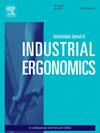老年人对软性外骨骼的需求:一项以人为中心的参与性研究
IF 3
2区 工程技术
Q2 ENGINEERING, INDUSTRIAL
International Journal of Industrial Ergonomics
Pub Date : 2025-09-17
DOI:10.1016/j.ergon.2025.103813
引用次数: 0
摘要
外骨骼提供显著的潜力,以提高流动性和支持老年人独立生活。然而,由于对不同用户需求和设计要求的理解有限,它们的广泛采用受到了阻碍。为了解决这一差距,我们进行了一项以人为中心的两阶段参与性研究,以确定软外骨骼设计和评估的用户需求、偏好和设计要求。第一阶段包括6个与行动不便的老年人及其家庭照顾者(n = 14)共同设计研讨会,重点关注生活经历、生理心理需求和设计期望。第二阶段涉及157名老年人的实验室评估,收集与外骨骼性能要求相关的行为、功能和生物力学参数。该研究确定了4个核心生理-社会心理需求、13个设计要求和9个客观性能基准。主要优先事项包括促进日常工作表现和活动能力,以培养独立性和防止受伤;确保舒适、个性化和耐用性;通过易用性、美学设计和可负担性来支持能力和自尊;促进社会联系和包容;并通过可访问性、数据安全性和透明度来维护伦理和道德诚信。9个评估基准包括生物力学、功能和行为参数,包括步长、步幅、握力、膝关节多角度最大自主收缩、步行速度、椅子站立性能和短体能性能电池得分。这一发现为将软性外骨骼与老年人复杂的生理、心理和社会需求结合起来提供了一个实用的、基于证据的框架,从而促进了老龄化社会的可用性、接受度和采用度。本文章由计算机程序翻译,如有差异,请以英文原文为准。
Older people's needs for soft exoskeletons: a human-centered, participatory study
Exoskeletons offer significant potential to enhance mobility and support independent living in older adults. However, their widespread adoption is hindered by a limited understanding of the diverse user needs and design requirements. To address this gap, we conducted a two-stage human-centered participatory study to identify user needs, preferences, and design requirements for soft exoskeletons design and evaluation. Stage 1 comprised six co-design workshops with older adults with mobility challenges and their family caregivers (n = 14), focusing on lived experiences, physio-psychosocial needs, and design expectations. Stage 2 involved laboratory-based assessments with 157 older adults to collect behavioral, functional, and biomechanical parameters relevant to exoskeleton performance requirements. The study identified four core physio-psychosocial needs, 13 design requirements, and nine objective performance benchmarks. Key priorities include facilitating daily task performance and mobility to foster independence and prevent injury; ensuring comfort, personalization, and durability; supporting competence and self-esteem through ease of use, aesthetic design, and affordability; promoting social connectedness and inclusion; and upholding ethical and moral integrity through accessibility, data security, and transparency. The nine evaluation benchmarks encompass biomechanical, functional, and behavioral parameters, including step length, stride length, handgrip strength, knee maximal voluntary contraction at multiple angles, walking speed, chair stand performance, and Short Physical Performance Battery scores. The finding offers a practical, evidence-based framework for aligning soft exoskeletons with the complex physical, psychological, and social needs of older adults, thereby promoting usability, acceptance, and adoption in aging societies.
求助全文
通过发布文献求助,成功后即可免费获取论文全文。
去求助
来源期刊
CiteScore
6.40
自引率
12.90%
发文量
110
审稿时长
56 days
期刊介绍:
The journal publishes original contributions that add to our understanding of the role of humans in today systems and the interactions thereof with various system components. The journal typically covers the following areas: industrial and occupational ergonomics, design of systems, tools and equipment, human performance measurement and modeling, human productivity, humans in technologically complex systems, and safety. The focus of the articles includes basic theoretical advances, applications, case studies, new methodologies and procedures; and empirical studies.

 求助内容:
求助内容: 应助结果提醒方式:
应助结果提醒方式:


